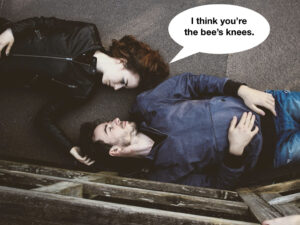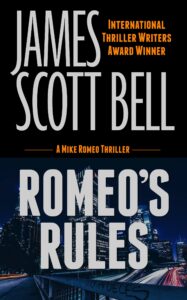by James Scott Bell
@jamesscottbell
 The subtitle of my book on dialogue is The Fastest Way to Improve Any Manuscript. The converse, of course, is that dialogue can sink a book pretty darn fast, too. Sodden, cliché-ridden talk is like cement shoes on a mafia stoolie. Many a book has been found at the bottom of the East River because the dialogue dragged it down.
The subtitle of my book on dialogue is The Fastest Way to Improve Any Manuscript. The converse, of course, is that dialogue can sink a book pretty darn fast, too. Sodden, cliché-ridden talk is like cement shoes on a mafia stoolie. Many a book has been found at the bottom of the East River because the dialogue dragged it down.
Before I get to the two most useless lines in literature, I have a runner-up. This couplet has been used so often it crossed over into the cliché zone around 1986:
“This isn’t about ____. It’s about ___.”
Now, you may have written such an exchange yourself, so I want to make something clear. I bear you no malice or derision. If you feel the absolute need to have a character say such a thing, I shall not throw a flag. I will, however, issue a warning. Clichés flatten the reading experience. Instead of delight, which is what you want to produce, the reader feels cheated. That feeling is usually subconscious, but why even flirt with that?
And by all means do not flirt with, entertain, or otherwise consider the two most useless lines in all literature:
“I love you.”
“I love you, too.”
I have never read this exchange (or seen it in a movie) except as a shorthand from the author demanding that I care about these people! They love each other, see? You now must love them, too, so that when tragedy befalls them you’ll really, REALLY care, because these are wonderful people who are in love, okay?
Only the effect is the opposite. It comes off as manipulation. It does nothing to make me believe the characters actually do love each other. Words are easy. You need to show me that they do. An action is aces for this, but an original line of dialogue counts as showing me, too.
Now, let’s nuance this a bit. While 98% of the time you don’t need the words “I love you,” there might be a few exceptions. Perhaps a man recovering from a traumatic brain injury, who finally opens his mouth to speak after months of silence, sees his wife at the bedside and utters, “I love you.”
Yeah, might work, though I think you could do better by thinking up some line of dialogue that was meaningful to them both early in the book, as in, “Let’s have chocolate croissants.” I dunno, you’re a writer, make something up. It’s more work than that easy-peasy “I love you,” but work that is worth it to a reader.
This cliché was demolished years ago in a commercial for a certain beer:
Or you can freshen the cliché by putting a spin on it, as Woody Allen does in Annie Hall:
ANNIE: Do you love me?
ALVY: Love is too weak a word for what—I lurve you. You know, I loave you. I luff you, with two F’s. Yes, I have to invent… of course I do. Don’t you think I do?
But for “I love you” followed by “I love you, too,” I cannot think of any exception. Find something else, anything else. The movie Ghost (1980) did it this way:
SAM: I love you, Molly. I’ve always loved you.
MOLLY: Ditto.
That word, Ditto, is not a throwaway, as it becomes a key clue later in the movie.
As I said, readers are cliché resistant. When they see one, it shoots past them without landing, without leaving any mark except a speed bump of dullness. The essence of dullness is predictability. Conversely, when you ditch a cliché for something original, it’s gladdens the reader’s heart.
UPDATE: I just remembered there’s a nuance here also. In my Romeo books, there are a couple of occasions when Mike’s friend and mentor, Ira, says something snarky yet insightful to him, and Mike replies, “I love you, too.” There it has an ironic twist. It’s also outside of the romantic love context which this post is primarily about.
So next time you’re tempted to have a character say “I love you,” and especially “I love you, too,” I want the words of Eliza Doolittle—as portrayed by the great Julie Andrews in My Fair Lady—pounding in your brain:

 Scenes are the bricks that build the fiction house. The better the bricks, the better the house. You don’t want bricks that easily crumble or aren’t fitted properly.
Scenes are the bricks that build the fiction house. The better the bricks, the better the house. You don’t want bricks that easily crumble or aren’t fitted properly.